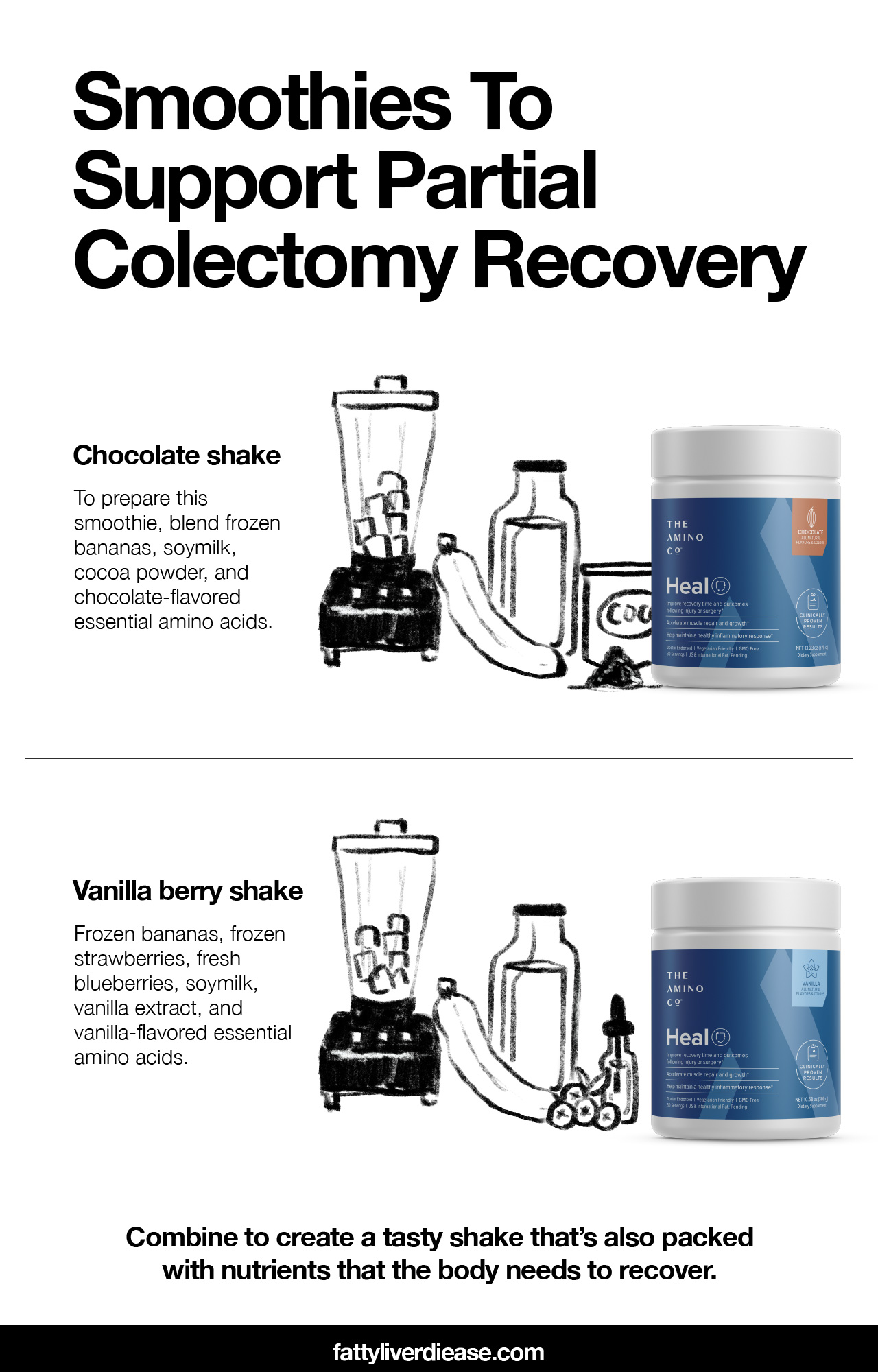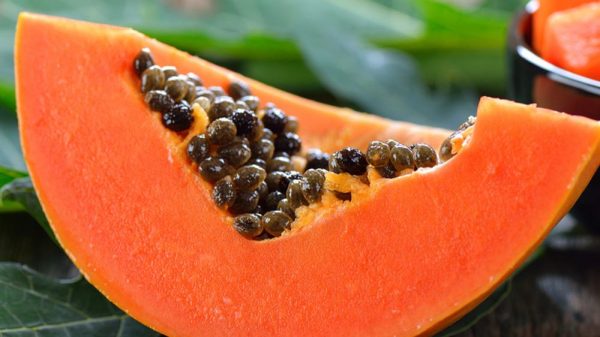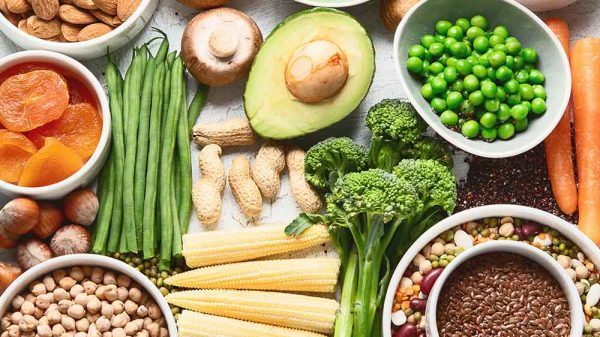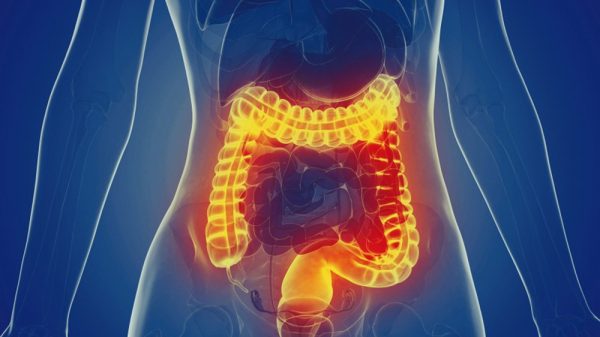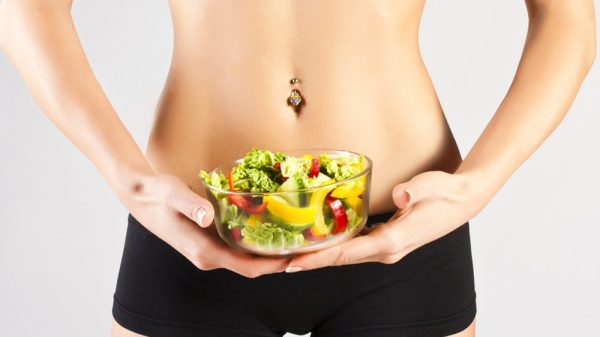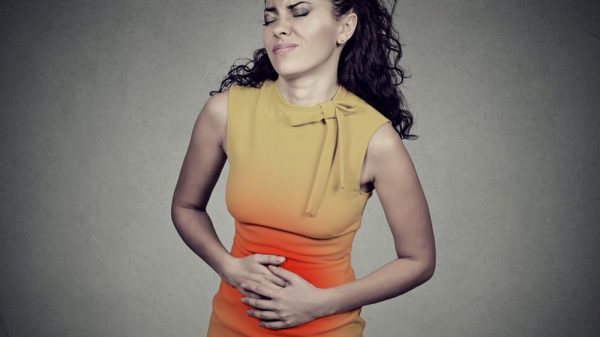Have you been told that you are a candidate for a partial colectomy? If you are considering this procedure, you are most likely wondering what to expect when you undergo a partial colectomy and what the recovery process looks like.
A partial colectomy is designed to remove a diseased portion of the colon and ultimately to increase your quality of life. Read on to find out more about the partial colectomy procedure and how to promote a fast and successful recovery.
What Is a Partial Colectomy?
First, let’s talk about what a colectomy is. A total colectomy is the removal of your colon, which is also known as the large intestine or large bowels. While a total colectomy removes your entire colon, a partial colectomy only removes a section of your colon. A hemicolectomy and a proctocolectomy are two other common types of colectomy procedures. A hemicolectomy removes a significant section of the colon and is usually specified as either a right hemicolectomy or left hemicolectomy. A proctocolectomy describes the removal of the colon as well as the rectum.
A partial colectomy is also called a colon resection surgery. When the damaged section of the colon is removed, the healthy parts are reconnected. The bowels then can function as normal. There are also different types of partial colectomy surgeries, such as a sigmoid colectomy, which removes a specific part of the colon.
Both partial and full colon removal surgeries are usually performed by a general surgeon.
Why Is a Partial Colectomy Performed?
A partial colectomy may need to be performed to remove a section of the colon that is diseased and causing unpleasant symptoms.
The following conditions may be resolved by a partial colectomy:
- Diverticulitis: Diverticulitis is a condition in which small pockets form along the inside of the colon. Food and stool can be forced into these pockets, causing inflammation and infection. Though antibiotics may be helpful, diverticulitis will likely reoccur unless the area of the colon with diverticula is removed.
- Colon cancer: If a cancerous growth is found, your doctor may suggest a partial colectomy to get rid of the cancerous area. For colon or colorectal cancer, removing the area of the colon with cancerous growths can help prevent spreading or metastasis.
- Ulcerative colitis: Colitis is a condition in which the bowels become inflamed and irritated. In the case of ulcerative colitis, small sores develop on the inside of the intestines, causing a significant amount of discomfort and other gastrointestinal symptoms. Dietary changes and medications can often help control inflammatory bowel diseases like colitis. However, if symptoms of IBD are persistent, a partial colectomy may help manage the condition.
- Bowel obstruction: A bowel obstruction occurs when food material or a kink in the bowels causes a blockage. In some cases, a bowel obstruction requires surgical removal of part of the colon.
- Crohn’s disease: Crohn’s disease is a different type of IBD that can affect either the small intestine or the large intestine and cause severe symptoms like cramping, diarrhea, and malnutrition. Although dietary changes and medications like immunosuppressants can be helpful, some cases of Crohn’s may be unresponsive to medications and treatment interventions. If this is the case, a partial colectomy may be considered to remove the problematic area of the large intestine.
Preparing for the Procedure
As with every type of surgery, you will need to undergo blood tests and other pre-operative tests to make sure you are in good physical condition to undergo surgery with general anesthesia. To prepare for colorectal surgery, you may also need a colonoscopy, so the surgeon can see exactly what part of the bowels needs removal and resecting.
Your surgeon will give you directions on how to prepare for the surgery, to help the surgical procedure go as smoothly as possible. You will likely be instructed to stop all blood-thinning medications leading up to the procedure, to reduce the risk of bleeding.
Leading up to partial colon surgery, you will also need to clear out your bowels. Your surgeon may instruct you to follow a liquid diet, take laxatives, and/or use enemas in the days prior to the surgery.
What to Expect During the Procedure
During the partial colectomy procedure, the surgeon will conduct the procedure laparoscopically or as an open procedure. A laparoscopic colon resection is a minimally invasive procedure. During a laparoscopic partial colectomy, the surgeon will make small incisions in the abdominal area and insert a tiny video camera called a laparoscope, so the surgeon can get a clear view of the large intestines. Small surgical tools will then also be inserted through incisions in the abdomen to cut and resection the bowel. Because laparoscopic colectomy tends to be a less invasive form of bowel resection, it may result in less scar tissue formation and a slightly shorter recovery time.
During open surgery, also known as an open colectomy, the surgeon will make a larger incision in the abdominal area so that the colon is exposed. The surgeon will then be able to cut, remove, and stitch areas of the colon as needed before sewing the abdomen closed again.
If the partial colectomy is performed to remove cancerous tissues, the surgeon will likely also remove nearby lymph nodes. Cancerous cells can travel from the lymph nodes to other parts of the body, so removing lymph nodes helps to prevent the spread of cancer to other areas of the body.
In some cases, the surgeon may need to perform an ileostomy or colostomy. Both procedures involve the creation of a stoma, which is an opening in the abdominal wall that allows stool to exit the body without passing through the large intestine. Many individuals have a bag attached to the stoma to collect waste outside of the body. Surgeons may elect to create a stoma to prevent waste from coming in contact with the healing area of the resected bowel. Since waste products contain bacteria, exposing an open wound to the stool can increase the risk of infection. An ileostomy joins the end of the small intestine to the stoma, while a colostomy connects a part of the large intestine to the stoma. The stoma is often temporary, though in certain cases, it may be permanent.
The entire partial colectomy procedure may last for up to 4 hours, depending on your specific case.
Partial Colectomy Recovery
In this section, we explore what you can expect during the recovery process following a partial colectomy procedure. We also provide some helpful tips to help you recover more quickly.
What to Expect After Surgery
A partial colectomy surgery is an inpatient procedure, which means that you will need to remain in the hospital for up to a week following the procedure so that nurses and doctors can monitor your progress. For the first 24 hours, you will feel extremely sleepy and possibly nauseous as you recover from general anesthesia.
In addition to a stoma, you may also have a catheter, which allows you to urinate without you needing to go to the bathroom.
You may also be attached to an intravenous method for receiving nutrition. This allows for the bowels to heal a little bit before they must handle food and liquid again. After a day or so, you will be able to begin consuming clear liquids.
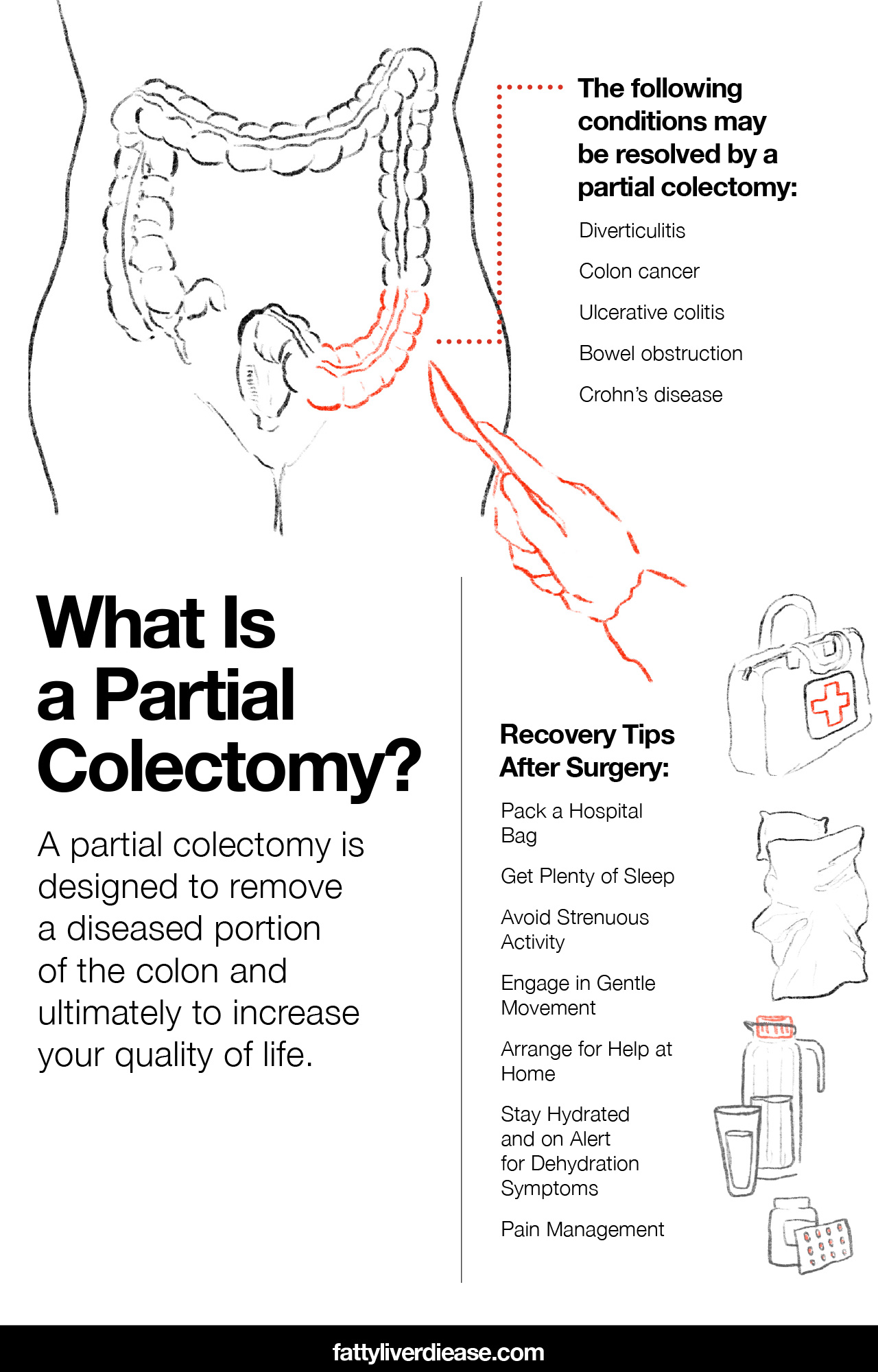
Partial Colectomy Recovery Tips
Here are a few tips for ways to make your life easier as you recover, as well as strategies for supporting a fast recovery.
1. Pack a Hospital Bag
You don’t want to be stuck in the hospital without your essentials. Make sure to bring some things to help make your stay more comfortable. Pack a bag with your toothbrush, robe, and blankets if you get chilly easily. Staying in the hospital, though it’s a necessary part of recovery from a partial colectomy, can also get boring. Bring a few things to help keep you occupied as you recover. For example, books, magazines, laptop, and movies can help you pass the time.
2. Get Plenty of Sleep
After you are discharged from the hospital to continue your recovery at home, you will likely feel very tired and a little bit weak. Make sure that you get plenty of rest while you recover. The body does a lot of recovery work while we are asleep, so it is especially important to frequently rest when recovering from a major surgery like a partial colectomy.
3. Avoid Strenuous Activity
During the first few weeks of recovery at home, it’s a good idea to avoid strenuous activities such as running, jumping, and dancing. These activities may pull at your wounds and increase the risk of injury. Make sure to check with your surgeon about when you can engage in strenuous exercise after surgery.
4. Engage in Gentle Movement
Although vigorous movement can damage your healing wounds, try gently walking around as soon as you are cleared to do so. Getting your blood circulating is important for preventing blood clots, which is a serious complication that can occur after surgery. Moving around as soon as possible after surgery can help ensure that the blood stays moving and doesn’t have a chance to pool.
5. Arrange for Help at Home
When you get home from the hospital, you won’t have the energy to take care of the household, do chores, or make food for yourself. Having a loved one help out with these things can make a huge difference in your recovery by relieving you of stress. Have one of your friends or family members help you stock the house with groceries and prepare meals.
6. Stay Hydrated and on Alert for Dehydration Symptoms
Normally, the large intestines are responsible for absorbing water from waste. However, after a partial colectomy surgery, your body will be adjusting and may lose more water than usual. Having a stoma in place will also increase the risk of developing dehydration. You will likely notice diarrhea in the weeks following a partial colectomy surgery, which indicates that water isn’t being absorbed as well, and you’re losing more fluids than usual.
As a result, it’s extra important to stay hydrated. Consume plenty of water and fluids that contain electrolytes. Gatorade and sports drinks are good options, as well as chicken broth. Just be sure to drink fluids in small quantities to avoid overwhelming the digestive system.
7. Pain Management
Pain management is a critical part of the recovery, allowing you to sleep and eat without the distraction of pain as you heal. When you are in the hospital, you will be given pain medication intravenously. When you go home to continue healing, you will likely be given prescription pain medication. When you finish this course of medication, you will be able to switch to over-the-counter options. Acetaminophen works fine; however, avoid NSAIDs like ibuprofen, since they can worsen bleeding and be irritating for the digestive system.
What to Eat Following a Partial Colectomy
Since a partial colectomy surgery directly affects the digestive system, you will need to be extra careful about the foods you eat as you recover. Here are some tips to make sure that your diet is colectomy-friendly.
1. Eat Soft, Easy-to-Digest Foods
When you can return home from the hospital, you will need to eat healthy foods that are both easy on the digestive system and soft in texture. You want to make sure you are eating foods that fight irritation, inflammation, and diarrhea. Further down on this list, we provide more specific guidelines about foods to eat and foods to avoid.
2. Eat Small Portions Slowly
Following a partial colectomy procedure, your bowels likely need time to adjust and can’t handle large quantities of food at one time. Instead, eat smaller quantities of food and chew deliberately and intentionally, to make the digestive process easier on the body.
3. Don’t Get Too Much Fiber
Normally, eating plenty of fiber is important for supporting healthy microbiome composition and gastrointestinal health. However, unlike a lot of surgeries that can cause constipation, a partial colectomy can actually cause diarrhea and watery stools, particularly if you have a stoma. Limiting your fiber intake is crucial in the immediate aftermath of your surgery.
So, what should you eat? Instead of whole grains, aim to eat refined grains that are as low in sugar as possible. Cream of wheat, crackers, and white rice are great examples of foods that contain low levels of fiber.
4. Eat the Right Fruits and Veggies
Even though it’s necessary to limit fiber intake after a partial colectomy, this doesn’t mean cutting out your fruit and vegetable intake altogether. Instead, it’s important to make sure you eat the right kinds of vegetables. Keep in mind that fruits and veggies are packed with vitamins, minerals, and antioxidants that support the immune system during healing. It’s best to eat starchy fruits and vegetables that are cooked and have the skin removed. Canned vegetables also work well. Here are a few examples of fruits and vegetables that you can eat when you’re healing from a partial colectomy:
- Sweet potato or white potato: Both skinless sweet potatoes and white potatoes are excellent options when recovering from a partial colectomy. Sweet potatoes contain a little more fiber and nutrients, while white potatoes offer less fiber and also fewer nutrients.
- Carrots: Cooked carrots are healthy and versatile, and low enough and fiber to be acceptable to eat after a partial colectomy surgery.
- Beets: Cooked beets are perfect post-surgery foods and offer tons of healing vitamins and antioxidants.
- Bananas: Bananas are a great post-surgery food option, and can help quell diarrhea. To ensure that you’re not eating too much fiber, reach for ripe bananas instead of unripe bananas.
5. Get Plenty of Protein
Protein is a critical nutrient for supporting a fast recovery following surgery. Dietary protein offers components called amino acids, which the human body needs to carry out almost all biological processes, including muscle synthesis and hormone production. So, what are some high-protein foods you can eat after a partial colectomy surgery?
- Nonfat Greek yogurt: Nonfat Greek yogurt that’s low in sugar provides optimal ratios of essential amino acids as well as calcium and probiotics to support healing and gut health.
- Fish: Fatty fish offers vitamin D and omega-3 fatty acids, and can be easily mashed to create a soft consistency.
- Chicken breast: Shredded chicken breast in chicken broth is a great way to get a balanced ratio of essential amino acids that you need for recovery.
5. Drink Smoothies
Smoothies are the perfect way to get plenty of nutrients and calories while also making sure that what you’re consuming is easy to digest. Here are a couple of ideas for smoothies that can support a speedy recovery.
- Chocolate shake: To prepare this smoothie, blend frozen bananas, soymilk, cocoa powder, and chocolate-flavored essential amino acids.
- Vanilla berry shake: Frozen bananas, frozen strawberries, fresh blueberries, soymilk, vanilla extract, and vanilla-flavored essential amino acids combine to create a tasty shake that’s also packed with nutrients that the body needs to recover.
6. Avoid Food That Could Be Harboring Bacteria
Certain foods, when eaten raw, can increase the risk of developing a bacterial infection. In particular, avoid raw beef, fish, shellfish, and eggs. Chicken should always be eaten cooked under all circumstances.
7. Slowly Return to a Normal Diet
Returning to your normal diet should be a gradual process. Your physician will give you direction on how to start introducing more fiber and solid food after the recovery period of about six weeks. Make sure to follow all of these guidelines for a smooth transition.
Things to Keep in Mind
Keep in mind that specific dietary recommendations will vary depending on your individual case. Always follow the direction of your surgeon and nurses who are providing your post-surgery care. It’s also important to check with your healthcare provider before taking any supplements.
Partial Colectomy: Conclusion
A partial colectomy is major surgery and is accompanied by significant changes to your lifestyle during the recovery process. When you are recovering from a partial colectomy, make sure that you are prepared for your hospital stay, arrange for help at home, and eat a colectomy-friendly diet that encourages healing. In a matter of months, your bowel function will be back to normal, and you’ll be back to feeling like yourself, but most likely without unpleasant bowel symptoms.
